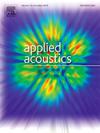Estimating the subjective severity of laptop fan abnormal sounds using psychoacoustic parameters
IF 3.4
2区 物理与天体物理
Q1 ACOUSTICS
引用次数: 0
Abstract
The demand for acoustic comfort in domestic appliances has seen a remarkable surge, with the laptop, a prevalent device in modern homes, often being a source of undesirable noise. Such noise, especially abnormal fan sounds, can adversely affect user comfort during operation. Manufacturers are thus keen to differentiate these abnormal sounds from the routine noise of laptop fans to ascertain potential issues. This study explored the relationship between the severity of abnormal laptop fan sounds and key psychoacoustic metrics through two subjective experiments. In Experiment 1, a group 24 participants evaluated 72 laptop fan noise stimuli, which were generated from records of laptop fans operating at 12 distinct speeds ranging from 2700 to 4900 rpm in 200 rpm increments. In Experiment 2, another group of 24 participants estimated 64 stimuli characterized by pronounced abnormal sounds across various fan speeds, with these sounds adjusted to have equal loudness at each rpm. The contribution of psychoacoustic metrics, i.e., loudness, sharpness, roughness, fluctuation strength, and tonality (hearing model), on the perceived severity of the abnormal sounds, was analyzed by partial correlation analysis. Psychoacoustic analysis revealed loudness dominance in abnormal noise perception, with the derived multivariate linear regression model demonstrating determination coefficient (R2 = 0.914). Cross-experimental validation established complementary mediation through roughness and sharpness modulations, suggesting their systematic incorporation with loudness as triaxial diagnostic parameters for enhanced anomaly detection in engineering applications.
利用心理声学参数估计笔记本电脑风扇异常声音的主观严重程度
随着现代家庭中普遍使用的笔记本电脑经常成为令人讨厌的噪音的来源,人们对家用电器的声学舒适性的需求出现了显著的激增。这样的噪音,特别是异常的风扇声音,会对用户的操作舒适性产生不利影响。因此,制造商急于将这些异常声音与笔记本电脑风扇的常规噪音区分开来,以确定潜在的问题。本研究通过两个主观实验探讨了笔记本电脑风扇异常声音的严重程度与关键心理声学指标之间的关系。在实验1中,一组24名参与者评估了72个笔记本电脑风扇噪音刺激,这些噪音刺激来自笔记本电脑风扇以200转/分的速度以2700到4900转/分的12种不同速度运行的记录。在实验2中,另一组24名参与者估计了64种刺激,其特征是在不同的风扇转速下发出明显的异常声音,并将这些声音调整为在每rpm时具有相同的响度。通过偏相关分析分析心理声学指标,即响度、锐度、粗糙度、波动强度和调性(听觉模型)对感知异常声音严重程度的贡献。心理声学分析显示响度在异常噪声感知中占主导地位,推导的多元线性回归模型显示决定系数(R2 = 0.914)。交叉实验验证通过粗糙度和锐度调制建立了互补的中介作用,表明它们与响度作为三轴诊断参数系统地结合在一起,可以增强工程应用中的异常检测。
本文章由计算机程序翻译,如有差异,请以英文原文为准。
求助全文
约1分钟内获得全文
求助全文
来源期刊

Applied Acoustics
物理-声学
CiteScore
7.40
自引率
11.80%
发文量
618
审稿时长
7.5 months
期刊介绍:
Since its launch in 1968, Applied Acoustics has been publishing high quality research papers providing state-of-the-art coverage of research findings for engineers and scientists involved in applications of acoustics in the widest sense.
Applied Acoustics looks not only at recent developments in the understanding of acoustics but also at ways of exploiting that understanding. The Journal aims to encourage the exchange of practical experience through publication and in so doing creates a fund of technological information that can be used for solving related problems. The presentation of information in graphical or tabular form is especially encouraged. If a report of a mathematical development is a necessary part of a paper it is important to ensure that it is there only as an integral part of a practical solution to a problem and is supported by data. Applied Acoustics encourages the exchange of practical experience in the following ways: • Complete Papers • Short Technical Notes • Review Articles; and thereby provides a wealth of technological information that can be used to solve related problems.
Manuscripts that address all fields of applications of acoustics ranging from medicine and NDT to the environment and buildings are welcome.
 求助内容:
求助内容: 应助结果提醒方式:
应助结果提醒方式:


